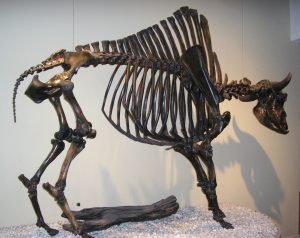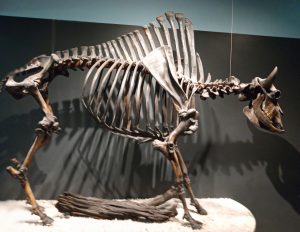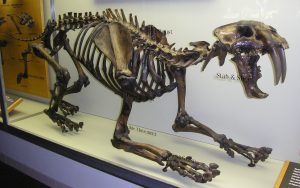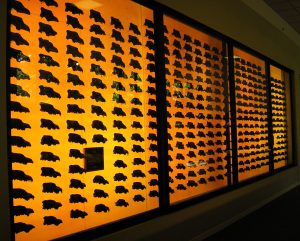This is article number five in my west coast fossil museum series. The La Brea Tar Pits are in the heart of Los Angeles not far from downtown LA. This location is heralded as “what may be the world’s richest deposit of Ice Age fossils.” * These fossils are unique because they have been discovered in the tar pits, and the museum has many fossils that have been salvaged from those pits. The museum’s current estimate is that workers have recovered nearly five million fossils!
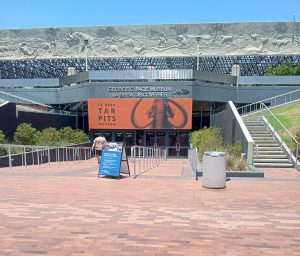 Page Museum Entrance at La Brea Tar Pits in Los Angeles.
Page Museum Entrance at La Brea Tar Pits in Los Angeles.
I have never lived in California but over my life travels I have visited La Brea at least four times. The most recent visits were in August 2008 and June 2023. Between those two visits not a lot has changed with the exhibits other than some updates and a new commitment to a “human-caused climate change” philosophy in the exhibits. They are also emphasizing plant and animal micro fossils now, not just the large vertebrate fossils that have always made up their most impressive displays.
La Brea Museum Reconstructed Antique Bison Skeletal Display (2008 left) & 2023 (right).
The area of asphalt deposits in which the fossils have been preserved is called Rancho La Brea. This means “the tar ranch” in Spanish. The tar was first recorded by Spanish explorer Gaspar de Portola in 1769. The masses of tar-covered fossil fragments were not recognized until the late 1800s. As with all other secular museums in America everything is interpreted according to the “deep time” geologic column where the earth is said to be 4.6 billion years old, and that life has evolved from inorganic material over the last 3 billion years or so. The plant and animal fossils at La Brea are interpreted using radiocarbon (carbon-14) dating methods and are said to have formed during a period of up to 50,000 years from the present. Most La Brea fossils are carbon dated at 11,000 to 15,000 years old. Creationists know this interpretation to be in error because the global Flood occurred around 4,500 years ago and no supposed pre-Flood fossil field like that at La Brea could have survived the actions of the catastrophic Flood. For a scientific explanation for why the secular scientists’ radiocarbon dates are incorrect click here.
La Brea Reconstructed Sabre-Tooth Cat Skeleton.
 La Brea Display of a Typical Tar-Encased Bone Jumble Mass.
La Brea Display of a Typical Tar-Encased Bone Jumble Mass.
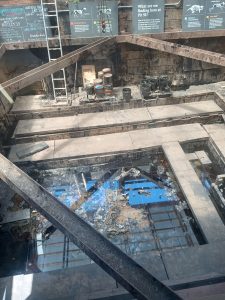 Fossil Excavations Continue in Pit 91 at La Brea Tar Pits in 2023.
Fossil Excavations Continue in Pit 91 at La Brea Tar Pits in 2023.
Famous Wall of Dire Wolf Skulls on Display at La Brea with Over 400 Skulls.
The current secular story for the fossils at La Brea reads: “For thousands of years, animals and plants have gotten stuck in shallow surface sheets of viscous asphalt, and over time these asphalt layers have built up into large cone-shaped deposits through continued asphalt seeping and sediment deposition.” *
A better interpretation is that the tar pits are the result of the actions of the global Flood at the time of Noah. In my book The Creation Dialogues-2nd Edition I have written a six-page explanation of the tar pits as being the result of the global Flood which to me makes more sense than the secular story. Plus, it allows for a close matching of La Brea events to the timeline of the Bible.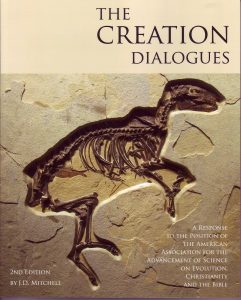
See pages 76-83 in this book for a Global Flood Explanation for Fossils at La Brea.
I do expect that anyone interested in fossils and ancient life would enjoy a visit to the La Brea Tar Pits whenever in the LA area. Just remember that everything is interpreted according to the anti-biblical perspective of uniformitarianism and millions of years of evolution. As I have stated many times in my writings this worldview is based on anti-God secular presuppositions and is not fact.
The La Brea Tar Pits are located at 5801 Wilshire Boulevard, Los Angeles, CA 90036.
J.D. Mitchell
*Lindsey, Emily, Editor, Rancho La Brea: Treasures of the Tar Pits-3rd Edition, Los Angeles County Museum of Natural History Foundation, 2018.
